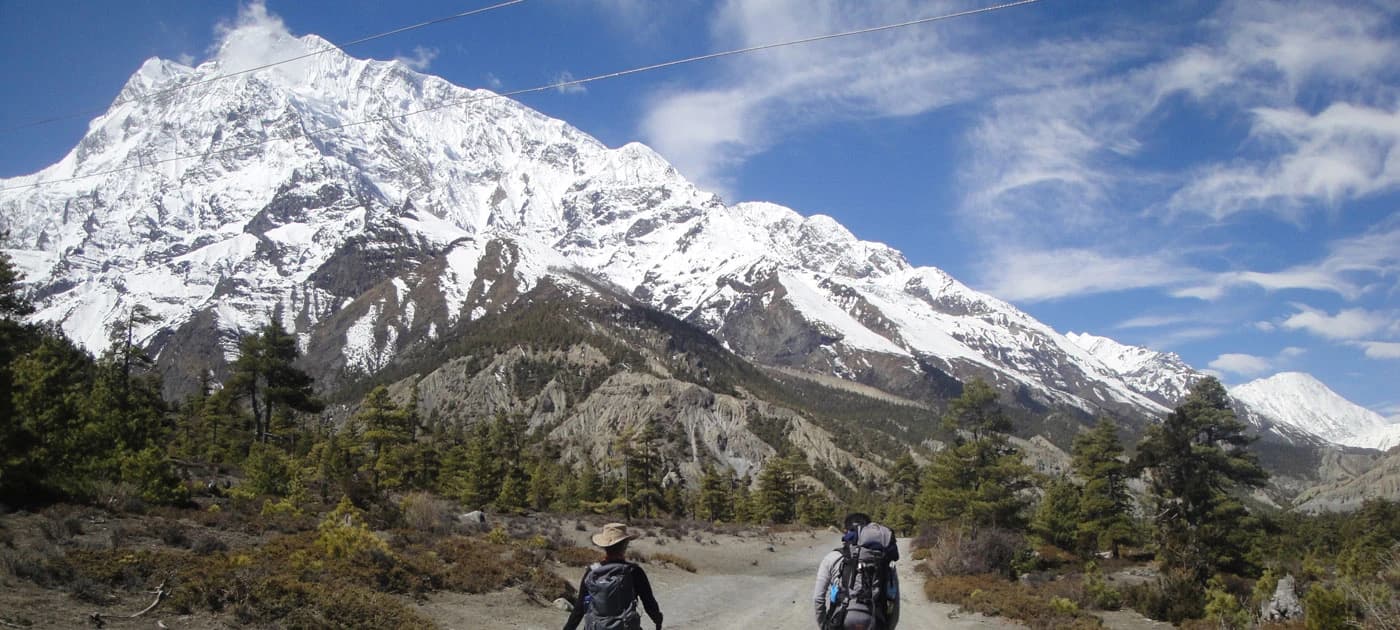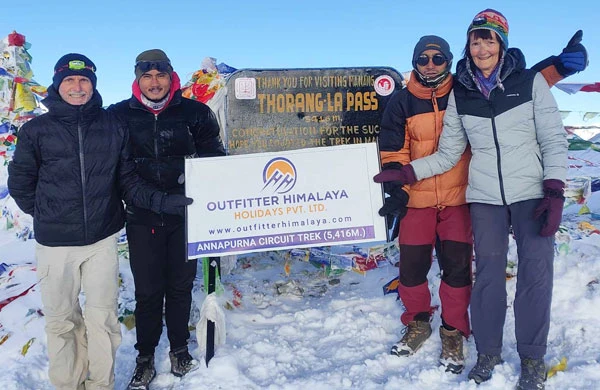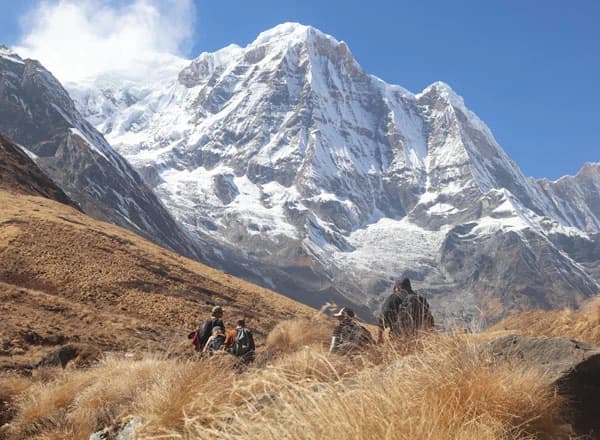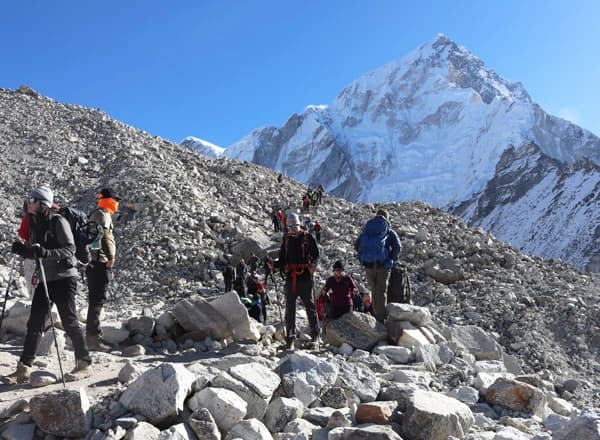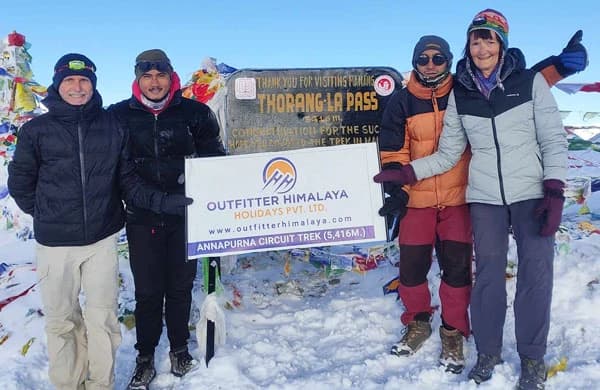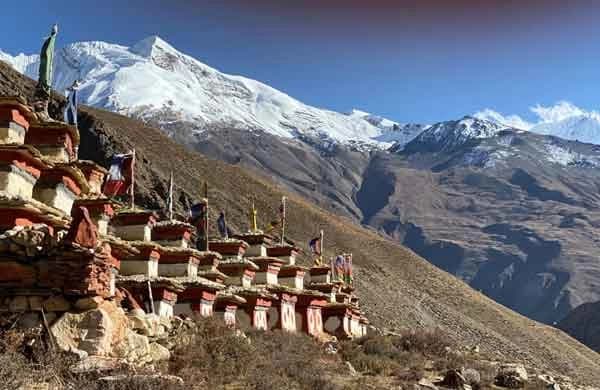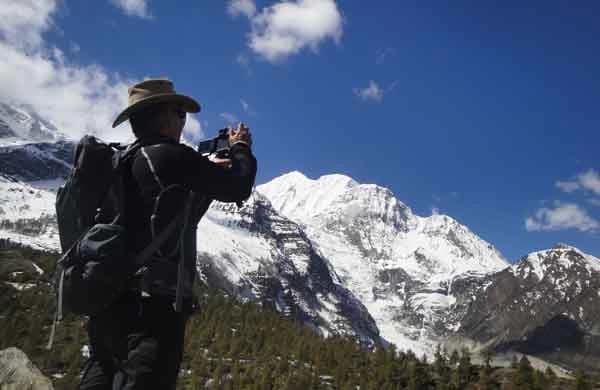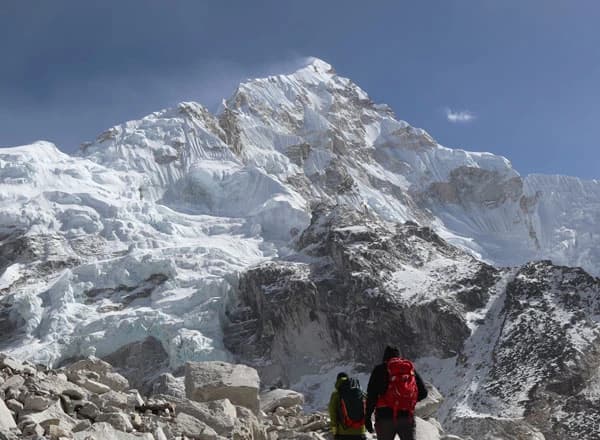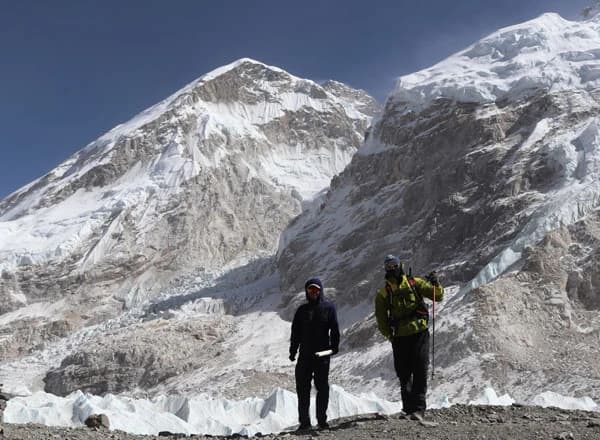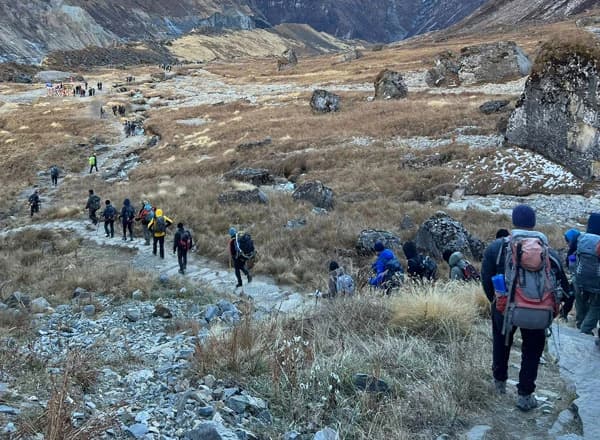Foods on the Annapurna Circuit trek is decent. You will have a variety of options to choose from. Usually, the menu is set in all tea houses. As the elevation rises, the option gets less.
Food and Drinks in Annapurna Circuit Trekking
Breakfast in Annapurna Circuit Trekking
- Bread and Chapati: Plain toast, plain toast with jam or honey, French toast, cheese toast, Tibetan bread, plain chapati, chapati with honey, peanut butter
- Eggs and Baked Beans: Eggs, boiled eggs, plain omelets, scrambled eggs, fried eggs, veg omelets, cheese omelets
- Pancakes: Plain pancake, pancake with jam or honey, apple pancake, chocolate pancake
- Porridge and Puddings: Oat porridge, tsampa porridge, apple porridge, honey porridge, porridge with cinnamon and raisins, muesli with hot milk, cornflakes with hot milk, rice pudding, chocolate pudding
- Soup: Garlic soup, tomato soup, mushroom soup, mixed soup

Lunch and Dinner in Annapurna Circuit Trek
- Rice: Dal Bhat (Veg), dal bhat (Non-veg), rice with chicken curry, rice with veg curry, cheese fried rice, veg fried rice, egg fried rice, tuna fried rice, mixed fried rice
- Noodles: Veg fried noodles, egg fried noodles, fried noodles with cheese, mixed fried noodles
- Pasta and Macaroni: Veg fried pasta, cheese fried pasta, pasta with cheese and tomato sauce, plain macaroni, macaroni with vegetables, cheese, and egg, mix macaroni
- Spaghetti: Spaghetti with tuna, cheese, and tomato sauce, cheese, spaghetti with tomato sauce, spaghetti with tomato sauce and vegetable.
- Momos: Veg momo, buff momo, chicken momo, cheese momo, potato momo.
- Pizza: Chicken pizza, mushroom pizza, mixed pizza
Dessert available on Annapurna Circuit Trail
- Apple pie, custard pudding, rice pudding, apple filter, cheese filter, chocolate pudding, fruits
What kinds of beverages are available during the trek?
The beverage option during the Annapurna Circuit trek is decent. Clean drinking water is rapidly available throughout the trail, along with fresh fruit juices, canned juices, teas, coffees, energy drinks, cold drinks, local alcohol, etc.
Note: Do not drink alcohol until you cross Thorong La Pass. Alcoholic drinks will dehydrate your body and make you prone to altitude sickness. Also, maintain your coffee intake as it also dehydrates the body.
Below, we have shared a bit more about beverages and how much it will cost you:
- Bottled water: Bottled water is available in most places along the trail. However, we do not recommend that trekkers buy bottled water during trekking. It will cost you five times more than in the city and is also very bad for the environment. Bottled water should be your emergency option.
- Boiled drinking water: Trekkers drink boiled water during trekking. Boiled water is available in all tea houses at a minimal cost of USD 1 to 2 per bottle. It is safe to drink.
- Tap water and stream water: Tap water in the mountains may not be easy to digest, so we recommend trekkers use a water purification tablet before drinking from the tap. The same goes for any other natural water source, including streams.
- Tea/coffee: Tea and coffee are widely available in all tea houses. You will find varieties like black tea, lemon tea, milk tea, green tea, black coffee, and milk coffee.
- Ginger honey lemon tea: Ginger honey lemon tea does not include tea leaves. It is one of the most soothing warm drinks for trekkers. This drink will also help you avoid altitude sickness, colds, fevers, etc. Make sure to have it once daily, at least during the trek.
- Fruit juices and energy drinks: Fruit juices and energy drinks are widely available in lower elevations, but their varieties become limited as the elevation increases.
- Soft drinks: Coca-Cola, Sprite, and other soft drinks are found in tea houses.
- Alcohol: Locals make wines, whisky, beer, rum, and other alcohol. Many Nepali alcohol brands are also available. Drinking alcohol is not recommended while ascending.
Are non-veg dishes available during the Annapurna Circuit trek?
In the mountains of Nepal, locals eat goat and yak meat. Buffalo meat is occasionally available, too. Chicken and eggs are also widely available. Fish is rare, but you may find dishes made out of dried fish in some places.
You will find a decent variety of non-vegetarian food while trekking. Some common dishes are curries, fried, stews, grilled, stir-fried, and soups. Chicken momo and chow mein are also widely available.
Most dishes, like thukpa, thenduk, pizza, past, etc, are available in non-veg. Likewise; you can also find dal bhat with meat dishes. Egg curry, boiled eggs, omelets, etc, are some famous egg dishes.
In lower villages, sausages are also available. Non-veg dishes are much more accessible in villages situated at lower elevations compared to the upper part of the trail.
Note: Trekkers have to understand that frozen meats are common in the mountains. We recommend that trekkers ask about the freshness of the meat and how long it has been frozen before eating it. Ask your guide to help you order the freshest non-veg dish.

Is the food served along the Annapurna Circuit trail fresh?
Tea houses source their produce locally. Most fruits, vegetables, and other ingredients are locally grown without harmful pesticides. A handful of species, grains, and other essentials are also transported from cities to mountains.
Overall, you will mostly have organic food during trekking. All the dishes will be prepared hygienically. Tea houses cook fresh food daily. Your dish will be prepared upon your request. Nothing is pre-cooked.
As you ascend higher, the food options will get limited because everything has to be transported from lower villages to the upper. Regardless of that, you will enjoy delicious fresh food.
Dried vegetables and grains are common staples among the villagers at high elevations. Because of the harsh climate and environment, fresh food does not last long. Therefore, villagers hugely rely on dried veggies, fruits, and other ingredients.
This way, they can store food for a long time without losing its nutritional value. The menu is similar for trekkers everywhere along the Annapurna Circuit trail. There will be a mix of Nepali and Western dishes.
Dietary considerations while on Annapurna Circuit Trek
Trekkers with allergies or any dietary restrictions should inform their travel agency and guide in advance. He will make sure your food is safe to eat. We also recommend you to be aware and check the ingredients before having the food to be safe.
Nepali foods contain many species and ingredients you may not know. Therefore, trekkers who are very particular about the food they consume should study Nepali food. Having general knowledge will help you a lot when ordering food.
We also recommend you carry your allergy medicine and some snacks for backup. Vegetarian food is widely available along the Annapurna Circuit trek route. However, if you are strictly following a vegan or gluten-free diet, you may have a hard time during trekking.
The good news is the most stable trekking food, dal bhat, is available in veg and is also gluten-free. Trekking requires lots of energy. On average, you have to walk 6 hours a day on rugged terrain.
Therefore, food rich in carbohydrates is a must for trekkers to gain ample energy to walk long hours. Be mindful and make sure your body is getting proper nutrition and energy during the trek. That way, you will not feel tired and will have ample strength to keep moving forward.

Tips on food and beverages
Even though not talked about much, food remains at the core of your trek and highly impacts your overall experience. You have to eat good food daily to maintain your energy and well-being. Below, we have shared a few tips that will make your culinary experience fantastic during the Annapurna Circuit trek:
- Hydration: Drink at least three liters of water every day during trekking. You have to keep yourself hydrated to avoid altitude sickness and exhaustion.
- Carry electrolyte powder/ORS: If possible, you should carry electrolyte powder during trekking. It will provide you with instant hydration and energy.
- Balanced meals: Have food rich in carbohydrates, protein, and healthy fats. You have to nourish your body well to enjoy and complete the trek.
- Portion control: Do not overeat or undereat. Listen to your body and have food that you can handle.
- Snacks: While packing snacks for the trek, maintain a balance between general and high-energy snacks.
- Eat slowly and combine some kind of fluid into your meals: Enjoy your meals and savor the flavors. Eating slowly will allow you to have better digestion and prevent stomach ache. Likewise, combine soup or some kind of tea with your meal.
- Local dishes vs. Western dishes: Local dishes will have authentic flavors compared to Western dishes. Western dishes will be delicious, too, but the flavors may be different because of a lack of ingredients.
- Food safety: Tea houses prepare and cook your meals hygienically. However, you also have to take care of your cleanliness. Make sure to sanitize your hands or wash with soap before and after eating your meals.
- Supplements: You can take necessary supplements like vitamins, magnesium, iron, zinc, etc. Make sure to get the supplement prescribed by your doctor.
- Acclimatization helping food: Soupy food will help you acclimatize. For example, have soups, teas, thukpa, thenduk, etc, regularly.
FAQ Regarding Foods and Drinks on Annapurna Circuit trekking trail
Are there vegetarian, vegan, or gluten-free food options available in Annapurna Circuit Route?
Vegetarian foods are widely available along the Annapurna Circuit route. However, there are not many options for vegan and gluten-free food. Trekkers who need a specific diet during the trek are requested to talk to us or their travel agency in advance.
How is the food quality and variety in teahouses in the Annapurna Circuit Trek?
The tea houses source most of their vegetables, fruits, and other ingredients locally. Some spices and ingredients are transported as well. The food quality is finest in the mountains even though the variety is limited.
Are traditional Nepali dishes like dal bhat available throughout the Annapurna Circuit trek?
Yes, Nepali dishes like dal bhat, momo, chow mein, stew, thukpa, thenduk, etc, are available throughout the trek.
Is it possible to get fresh fruits or vegetables on the Annapurna Circuit trail?
Fresh fruits and vegetables are widely available to purchase along the trail. Make sure you have cash on hand to pay.
Can trekkers rely on the available food for proper nutrition, or should they bring supplements for the Annapurna Circuit Trek?
Yes, trekkers can rely on tea house food for proper nutrition. During trekking, your food must be rich in carbohydrates to get ample energy to walk 6 hours a day. The trail foods are designed to be rich in carbohydrates and protein and include other essential nutrients.
Are there meal options tailored for trekkers with dietary restrictions or allergies on the Annapurna Circuit Trail?
Tea houses do not provide tailored meal options. But if you need specific food or have allergies, we recommend sharing it with us. We will do our best to curate the meals as per your requirements.
Is safe drinking water readily available, and what are the purification options on the Annapurna Circuit Trekking trail?
During trekking, you will drink boiled water. They are safe to drink, and everyone, including guides, porters, locals, and trekkers, drink them. If you plan to drink water from a stream or tap during trekking, we recommend using a water purification tablet to treat it. You may not be able to digest mountain water without sterilizing, so be careful.
How much do meals typically cost at various altitudes on the Annapurna Circuit Trekking trail?
You can expect to pay USD 8 to USD 10for a decent meal. The cost of food is high at the upper elevation.
How much does accommodation typically cost per night on the Annapurna Circuit Trek?
The accommodation can cost USD 8 to USD 12 per night in teahouses.
Are there specific dishes or foods to avoid on the Annapurna Circuit Trekking trail?
We recommend trekkers to avoid or at least inquire about the meat freshness before ordering non-veg food during trekking. Likewise, if you have any allergies, make sure to tell the lodge owner to avoid adding them to your food.
Is it better to bring some ready-to-eat meals or snacks for emergencies in the Annapurna Circuit Trek?
We recommend trekkers pack snacks, protein bars, nuts, and other ready-to-eat food for the trail.
Conclusion
If you are planning to do the Annapurna Circuit trek and are worried about the food quality and availability, then you can rely on this information. Most of the meal are included if you book a packaged Annapurna Circuit Trek. Some of the most popular Annapurna Circuit Trek packages are the Annapurna Circuit Trek, Short Annapurna Circuit Trekking, Tilicho Lake with Thorong La Pass, Nar Phu Valley Trek with Thorong La Pass and Annapurna Circuit with ABC.
We also have shared information about the foods available in other trekking routes in Nepal which are:
Is an Everest Base Camp Trek in February possible? Yes, it is, and it is enjoyable. Given this month's poor reputation for unstable weather and a cold climate, February sounds like a very odd time [...]
Start the New Year with a challenge of a lifetime that will shape you to become the most excellent version of yourself. Join us for the Everest Base Camp Trek in January and get guided [...]
It is undoubtedly possible to trek in Nepal during the winter season, which lasts from December to February. December starts the winter season, and February ends it. So, trekking in Nepal in December and February [...]
